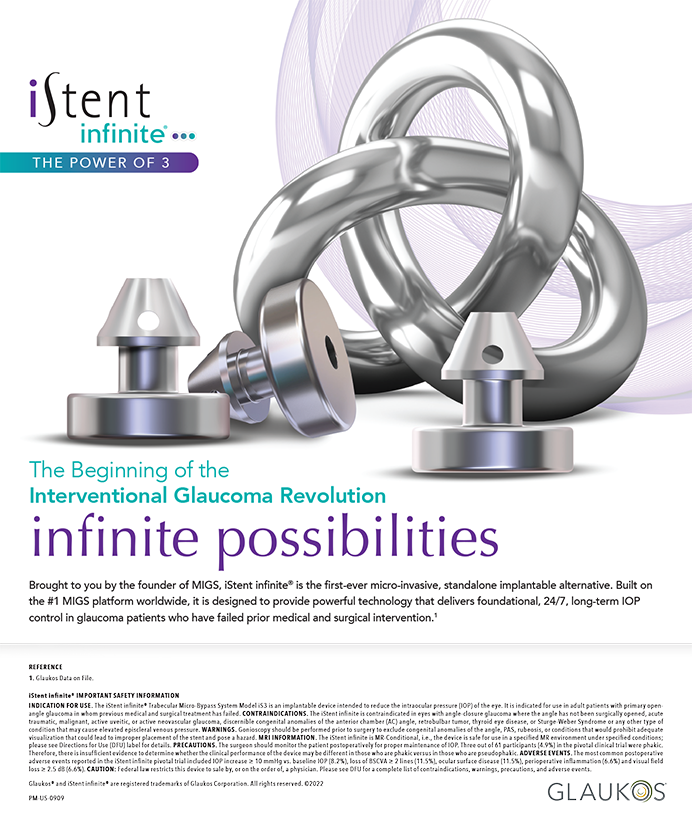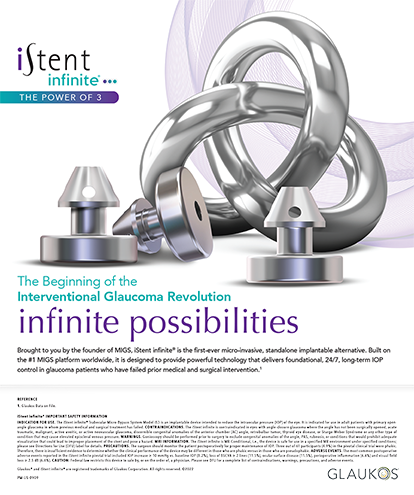A 12-year-old white male presented with a rapidly progressing cataract as well as hand-motion vision in his right eye 2 weeks after suffering a contusion injury while playing paintball. Slit lamp examination revealed 1+ cell and flare, although the patient was taking topical prednisolone acetate. His IOP measured 22 mm Hg despite treatment with timolol. Iridodialysis was visible between the 3:30- and 5-o'clock positions, and there was a small contralateral angle recession. I perceived no vitreous within the anterior chamber, and no phakodonesis was present. B-scan revealed an attached retina with debris in the vitreous cavity. I suspected a traumatic rupture of the posterior capsule, although I lacked the high-frequency ultrasound (ultrasound biomicroscopy) needed to delineate it precisely.
How Would You Proceed?1. How would you create the capsulorhexis?
2. How would the possibility of an open posterior capsule influence your approach to lens removal?
3. What lens style and position would be most appropriate?
4. Would you repair the iridodialysis? If so, how?
SURGICAL COURSE
After administering general anesthesia, I stabilized the anterior chamber with a cohesive, highly viscous viscoelastic solution (Healon GV; Pfizer Inc., New York, NY) and dyed the capsule through a superior paracentesis. I was careful to avoid overfilling the chamber with viscoelastic and used more viscoelastic from distal to proximal in relation to the wound in order to remove all the dye and maintain the chamber for the capsulorhexis. I initiated the capsulorhexis with a sharp, zonule-friendly cystotome (pinching the capsule with forceps places more stress on the zonules than does sharply opening it) and sensed no zonular weakness. After creating a clear, self-sealing corneal temporal incision at the 9-o'clock position with a diamond knife, I used forceps to complete the continuous circular capsulorhexis. It was slightly small at 5 mm, due to the potential need for optic capture. I cleared erupting lens milk with minute amounts of viscoelastic solution in order to prevent any interference with visualization.
In lieu of hydrodissection and hydrodelineation, I removed the lens via a dry technique, for which I employed a cannula on a syringe to perform gentle aspiration under viscoelastic control without irrigation. It was almost immediately evident that vitreous was already mixed with lens material through a central posterior capsule rupture (Figure 1), so I reversed aspiration to avoid any vitreous traction.
Due to the risk of posterior segment trauma and a lack of visualization through the white cataract, I chose an anterior, rather than a pars plana, approach for the vitrector. After removing the irrigation sleeve from the vitrector, I placed a chamber maintainer on the irrigation line and secured it through the superior paracentesis. I then introduced the noncoaxial anterior vitrectomy handpiece into the anterior chamber through a second clear corneal paracentesis sized to be watertight around the vitrector inferotemporally. I ensured that the original temporal clear corneal incision would self-seal during these maneuvers in order to maintain a closed system, because vitreous will track along a pressure gradient from high to low and prolapse will turn into vitreous loss if flow is allowed around instruments through any incision.
Some material was present within the vitreous cavity preoperatively. I set the vitrector at a maximum cut rate with enough vacuum to move the viscoelastic while adjusting the bottle height to maintain a formed chamber. The default mode allowed the activation of cutting before the use of suction until the nuclear material, which was entirely soft, and admixed vitreous were removed. No second instrument was needed. When cleaning the bag, I switched the machine setting to foot pedal position two or “I/A Cut” mode to allow the vacuum to remove the remaining cortex while respecting the integrity of the anterior capsular rim. I prefer this method to I/A handpiece use, because, if more vitreous appears, cutting activated by foot position three can immediately eliminate traction.
Inspection revealed that the posterior tear was sufficiently large and peripherally located to preclude its conversion to a posterior continuous capsulorhexis. I will only implant a lens within the bag if I can successfully complete this maneuver. Had the posterior capsule been intact, I would have chosen a one-piece acrylic lens for placement within the bag with a targeted postoperative refractive error of -0.25 D. Because the posterior capsule was open and the anterior capsulorhexis was perfectly sized, I selected a three-piece acrylic lens. After placing the haptic into the sulcus by means of a cartridge inserter, I captured the optic through the capsulorhexis and drew it into the bag (Figure 2), thereby assuring IOL centration. I find that a 6.5-mm optic is unnecessary, even for a large eye, when this maneuver is successful.
Next, I focused on the iridodialysis because of the risk of diplopia through this inferonasal defect as well as the cosmetic aspect of the condition. Because the patient's pupil allowed visualization, indirect ophthalmoscopy was not required. After instilling Miochol E (Novartis International AG, Basel, Switzerland) to encourage miosis, I placed a double-armed, 10–0 PROLENE suture (Ethicon Inc., Somerville, NJ) ab interno that exited under a conjunctival peritomy. Taking care not to catch any corneal fibers, I placed each long, straight needle—under viscoelastic control—through the clear corneal incision, across the anterior chamber, and through the peripheral root of the iris. I then passed the needles out of the sclera approximately 1.0 to 1.5 mm posterior to the limbus. I found it helpful to place a second instrument through the paracentesis to stabilize the iris while it was skewered. After splitting the iris defect into thirds, I removed the needles, tied the two ends of the suture on the surface of the sclera, and reevaluated the correct iris position without excessively tightening the suture. I then buried the knot under the sclera and verified the conjunctival closure.
I was able to carefully remove viscoelastic from the anterior chamber by means of an I/A handpiece, because the captured optic now effectively tamponaded the vitreous face. After verifying that all incisions were watertight, I put the iris at rest with topical atropine and administered a carbonic anhydrase inhibitor intravenously. Next, I applied a topical fourth-generation fluoroquinolone at a loading dose and prescribed topical nonsteroidal and steroidal anti-inflammatory drops for postoperative use.
OUTCOME
The patient achieved 20/30 UCVA on the first postoperative day despite the presence of floaters. His BCVA eventually stabilized at 20/20 with a small astigmatic correction. His IOP was normal without medication, and the patient had no complaints of glare. The indented fundus examination showed a small area of commotio retinae paracentrally with no macular edema or peripheral tears.
DISCUSSION
Capsular dyes are indispensable in cases such as this one, and I anticipate the widespread availability of trypan blue in the US, because it is the standard of care in other regions of the world. Trypan blue is currently the most cost-effective, nontoxic, and efficacious dye on the market. I personally prefer not to use an air bubble, especially in the setting of an open capsule, because I cannot afford to lose control of anterior chamber stability. The bubble was originally designed to avoid contact between the dye and the endothelium due to toxicity concerns, but a viscoelastic serves the same purpose while also maintaining the chamber. Trypan staining will still be visible in the capsule at the end of the case and aid in the capture of the optic.
Even slow-motion phacoemulsification can push lens material through a pre-existing posterior capsule aperture. For that reason, until I have identified the status of the capsule, I favor a dry technique, which requires that the surgeon have facility with the vitrector and its many options. The surgical staff must also be well versed in this rarely required aspect of surgery.
I have come to prefer multifocality for cases of uncomplicated unilateral cataracts in children, because these IOLs improve pediatric patients' depth perception and better simulate bilateral accommodation. When the posterior segment is involved or when significant iris and trabecular damage is present, however, I prefer a monofocal implant. Problems such as macular edema or future glaucoma that can potentially decrease the contrast sensitivity of the eye will result in suboptimal vision in low light conditions for an eye implanted with a multifocal lens. Whenever zonular or capsular conditions threaten centration, the risk/benefit ratio increases, and a monofocal implant is required. I also prefer acrylic to silicone lens material for an eye in which I anticipate inflammation or a possible future retinal detachment.
When repairing an iridodialysis, it is critical to bury the knot under the sclera to avoid late erosion, which can occur even with a partial-thickness scleral flap. The faint blue suture becomes almost invisible under the healed conjunctival flap, but the patient must be informed that well-meaning eye care practitioners he encounters in the future should never cut the suture. This admonition is even more important when there is a suture-fixated device, the iris will never truly heal, and the defect may even open years later without the suture's support.
By recognizing the likelihood of a posterior capsule rupture preoperatively, I obtained an optimal result in this case, save for the patient's need for progressive add spectacles for symmetric near vision. Patients without two sound eyes may be best served by the use of safety glasses. I hope that the future holds a larger selection of multifocal or accommodative lens implants that may be safely used in complex cases such as this one.
Lisa Brothers Arbisser, MD, is in private practice in Davenport, Iowa, and is the immediate past President of the American College of Eye Surgeons. She does not hold a financial interest in any of the products or companies mentioned herein. Dr. Arbisser may be reached at (563) 323-8888; drlisa@arbisser.com.


